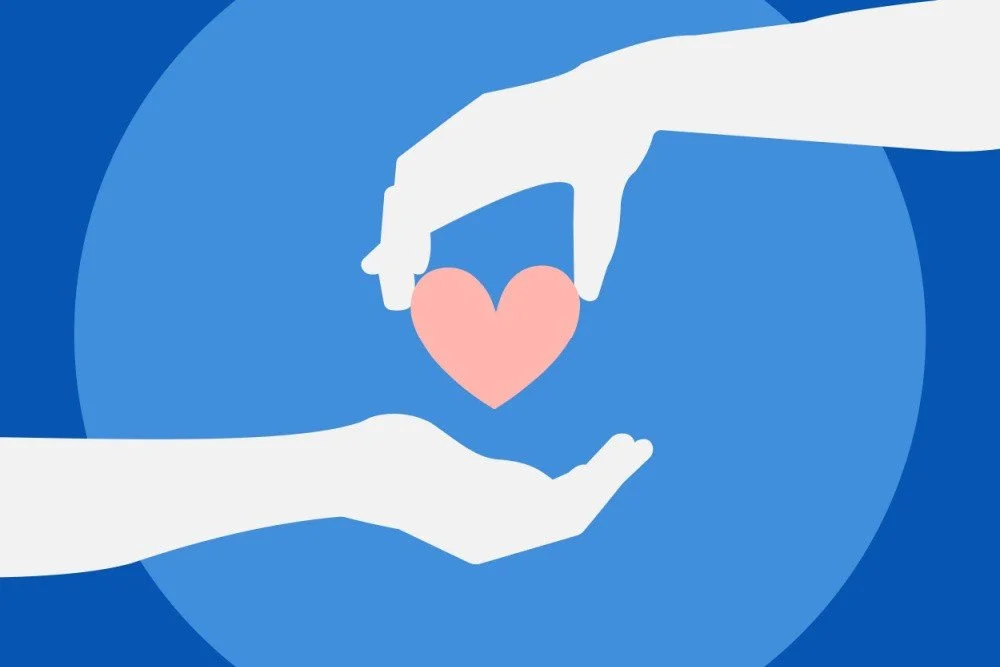Last week's Theatre Communications Group conference presented a changing perspective on audience engagement that uses technology. Tweet Seats are definitely on the outs. This 2 post series, however, focuses on the more immersive experience with two organization's successfully engaging their audiences. Their audiences must engage in some if not multiple forms of technology to partake in the theatrical story itself. The two organizations are Dog and Pony DC based in Washington DC and Rude Mechanicals based in Austin. Both use technology before, during and after the show. Dog and Pony DC's company member, Colin K. Bills, presented as part of a panel led by David J. Loehr of twitter handle @2amt (and 2amtheatre.com).
If Van Gogh Had Google Glass...
According to Google executives, Google Glass, a new type of high tech glasses, will be released to the public at the end of this year. By bringing heads up display-style views into our daily life, Google’s Glass project will enable users to interact simultaneously with their surroundings and the internet in a dynamic and instant way. An engineer who had the opportunity to try out the Google Glass released a video showcasing how she will use Google Glass in the future:
[embed width="560" height="315"]http://youtu.be/9c6W4CCU9M4[/embed]
The tech giant has set up a competition on Twitter and Google+ to explore potential ways to use the new product and give some lucky winners the shot at owning a pair of Google's glasses. "We're looking for bold, creative individuals who want to join us and be a part of shaping the future of Glass" writes Google. If you don’t think Google Glass will impact Arts Management, you sure might after reading the following 10 interesting ideas posted @Twitter #ifihadglass :
- I would use it to show people how I make it through life and do to work on my art,missing my right arm.
- I'd treat the world as my canvas; I'd share the art that is the human experience, and rejoice in music, travel, life and love!
- I would record the process start to finish as I make new pieces of art.
- I would show the galleries and art exhibits for others to see the art if they don’t have time, and the art scene in San Francisco.
- I'd give free guides to tourists explaining the history and meaning of obscure pieces of art.
- I would like to use google glass in Art museums to pull up all information and references for each artwork I viewed
- I would be excited to test potential uses for museums, immersive experiences and digital learning about art, culture, history.
- Analytics and Art. Figuring out what parts of the day my brain drops from memory, where its focusing, and why.
- Explore the combination of the virtual and the real through performance art. Collaborate with fellow artists through what I see.
- If I had glass, I would redesign the way that we shoot videos and take photography, helping viewers immerse themselves in art.
One of the most amazing impacts of Google Glass would be that Google Glass has the ability to offer a new perspective for audiences to appreciate art—from an artist’s perspective. Google Glass enables an artist to record and show the whole process of making an artwork, offering opportunities for audiences to watch every minute change the artist makes in the work. Imagine if Van Gogh had recorded his process from start to finish when he was painting "Sunflower," how amazing it would be if his audience saw how he mixed colors, sketched on canvas, drew lines, or grabbed a painting brush. Everyone is likely to think as an artist if he/she could watch the birth of an artwork from an artist’s eye. I believe that by appreciating artworks from an artist’s perspective, audiences will be moved and surprised by details that cannot be seen from the final artwork, or noticed from curators’ words, since the power of art lies in the creation process more than the final “product”.
The Peril of Tweet Seats
Stop me if you’ve heard this one – your local symphony has an upcoming production, and in order to draw in a younger crowd offer Tweet Seat tickets. The young kids come, spend the performance merrily on their phones, and head home. The next week, the symphony is slapped with a cease and desist – wait, what? I’ll start at the beginning. Tweet Seats are a new engagement tactic for performing arts organizations, utilizing social media and modern technology. The idea is that some seats in your house are reserved for people who wish to utilize their phone during the show. These patrons use Twitter or other social media to discuss and engage the performance at hand. Usually these seats are less expensive and in the back of the house, so as to not disturb the other patrons.
Some people (read: me) love the idea – others hate it, and the most thoughtful question its ability to truly increase engagement. Regardless, Tweet Seats are here to stay. Huffpo has written on them, Wolf Trap has used them, and now some troll claims to have successfully patented them.
The story dropped back in March, but it’s still very relevant to anyone considering using Tweet Seats in an upcoming production. Inselberg Interactive is the company holding the patent, whose language refers specifically to sporting events, but they have already demanded license fees from a nonprofit theatre in Connecticut. Ars Technica has the full story and analysis, but it basically boils down to this:
The company holding the patent doesn’t claim to have invented the smart phone technology or the social media apps Tweet Seats utilize. They claim to have invented the process of, I don’t know, tweeting at live events. Still with me? Good.
Patents, according to the US Patent and Trademark Office protect inventions and improvements to existing inventions. They also, according to my one semester of law class, must be novel and non-obvious. This patent was issued in 2005: Twitter didn’t exist and baby Facebook was just starting to let high school students in. At that time, this probably was a novel idea – but it was just an idea. Patents don’t usually apply well to ideas, they need a more tangible form.
Patents can be challenged and litigated against, but that costs time and legal fees. Given that this troll has turned their focus to the non-profit world, it’s unclear if those are available resources.
And when you consider that patents have a minimum shelf life of 14 years, I don’t think it’ll be going away unless someone smacks them down in court.
The Meaning of the Moment
On November 16, The New York Times published an essay by its music critic Anthony Tommasini reflecting on several of his favorite moments in classical and operatic repertoire. “I’m not talking about big climactic blasts or soaring melodies,” he writes, “but about some fleeting passage, an unexpected twist in a melodic line, a series of pungent chords, a short theme that reappears briefly in a new musical guise. Often these moments are subtle and quiet, almost stealthy.” He describes such moments as magical, fleeting, transcendent. Be it listening to a piece of music, sitting in a theater, watching a dance, or gazing at a piece of art, lovers of every art form surely know the sensation of which he writes—those split seconds where time seems to stand still and we are immersed in a realm beyond ourselves. As part of the project, Tommasini asked readers to share their own experiences of musical treasure. Overwhelmed by the response (to date, the query has received 875 replies and counting), what followed is a nine-part video and blog series in which Tommasini takes off the hat of critic and dons the role of teacher. Each video dissects one particular musical moment. Seated at his piano, Tommasini plays through the passage in question, simultaneously discussing its musical narrative and highlighting the particular nuances that cause it to grab the listener just so.
[embed width="560" height="315"]http://www.youtube.com/watch?feature=player_detailpage&v=AkeOC36Bmpo[/embed]
Like any fine instructor, Tommasini presents the subject matter with enthusiasm and knowledge. But unlike a lecture from an expert, the relevance of the session is derived as much from the audience as the teacher. Essentially the project asks devotees of an art form to reflect on their devotion. The subject is important not because an expert declares it so, but because the listener does. Tommasini comments in a follow-up essay on December 9 of the passion, intelligence, and clarity with which readers replied. Of the end of Debussy's Clair de Lune, one writer comments on the change of a single note, resulting in a "subtle change of harmony, like the instant of recognizing first love on a moonlit night." These moments, though brief, are deeply felt and moreover, personal.
As an engagement tactic, it’s a strikingly simple concept. Ask your current audience what moves them. Nudge them to remind themselves of their passion for what you do. In the process, create a forum for lively conversations to occur and then listen to what is shared. Tommasini’s “Musical Moments” project, of course, is able to utilize the human, financial, and technological resources contained at The New York Times. But with such a fundamental question driving it, we wonder if any arts organizations have taken on similar endeavors. To current arts managers who follow our blog, how does your organization garner feedback from the audience about their motivations for the art form you present? To arts patrons, have you participated in anything along the lines of the “Musical Moments” project? Would you want to?
Image Credit: Jillian Tamaki, Copyright 2012 The New York Times Company.
Crowd-Sourced Curating at the Brooklyn Museum
As the arts world continues to discuss and reconsider what it means to participate in the arts, the Brooklyn Museum is testing a new construct of audience engagement with its current exhibit GO: A Community-Curated Open Studio Project. GO combines two existing tactics: inviting the public into studios of working artists to see where and how artwork is made, and crowdsourcing the selection of that artwork through an open voting process. Unlike ArtPrize, an art competition in Grand Rapids, MI, that awards cash prizes to artists as determined by public vote (juried awards were added in 2012) and cited by the Brooklyn Museum as inspiration for the current exhibit, GO asks participants to nominate artists—rather than specific pieces—whose work they would like to see exhibited at the museum. The catch is that to be eligible to vote, participants must first visit at least five artist studios, which in turn requires that the museum be able to track where people go. The answer is a multiphase project begun this past September and culminating in an exhibit of Brooklyn artists, on display through February 24.
To participate, the museum first asked individuals to register on the GO community project website. Then, over a two-day open studio event involving nearly 1,800 artists in 46 Brooklyn neighborhoods, participants “checked-in” at each studio visited by way of a unique number displayed onsite. By sending that number to the museum either by text message, a free custom iPhone app, or the web, participants documented where they traveled. Those who checked-in at five or more studios received an email with instructions on how to vote, having earned the opportunity to nominate up to three artists. The museum tallied the results, sent two of its curators to review the work of the top ten nominated artists, and selected five to exhibit.
But GO didn’t stop when the voting was done. By asking participants to check-in, the museum was able to analyze how many people went where, when, and what platform they used to check-in, all of which was then shared in a series of posts on both the GO blog and through the Statistics section of the GO website. (Among those findings: Despite multiple mobile-friendly options designed especially for the event, nearly half of the 6,100+ participants chose to simply write down studio numbers throughout the day and check-in via the project website once back home, surprising project coordinators.) The website also provided a forum for participants to discuss (in real time and afterward) what they did and did not like about the process, share stories from their studio visits, learn about nominated artists, receive updates on the creation of the exhibit, and provide reactions to the final exhibit itself.
The exhibit has been criticized by some for not aptly representing the rich artistic quality Brooklyn holds, and is generating commentary on the age-old curatorial question of who should decide what constitutes “good” art. While a worthwhile debate, it seems to belie the larger point of the project: to expose people to the creative process, and ideally, to facilitate a better understanding of it. On that score, GO appears to have succeeded mightily. As project coordinators tagged entries in the Shared Stories section of the website, one of the most frequent themes to emerge was that of discovery. It seems that by opening studio doors, inviting people to participate in the curatorial process, and sharing reactions online, GO fostered meaningful interactions among artists, voters, volunteers, and museum staff, and in the process, created an innovative approach to engage audiences in the arts.
For Those of You Who Can't Stand It Anymore: A Homemade Cell Phone Jammer
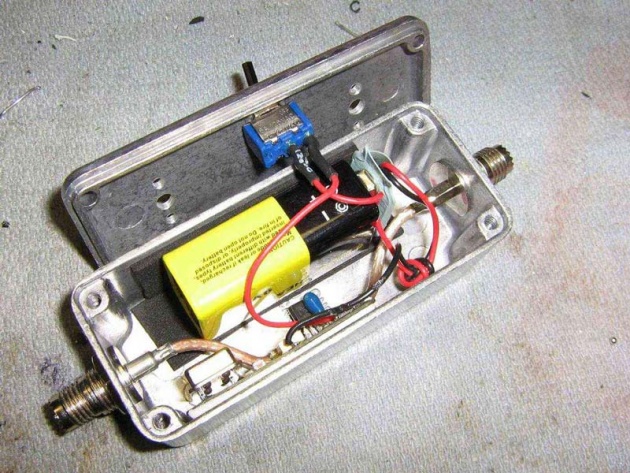 The invention of the cell phone and more specifically the advent of text messaging and smart phone technology have been disruptive to the traditional theatre environment. For some, even now, the thought of being distracted by the light they give off, the sound of tapping keys, and the sound a phone on vibrate is enough to cause an altercation.
Please note that actually building a cell phone jammer is against the law in the US and many other countries. Having said that, Wired recently published instructions for how to create a device that broadcasts disruptive signals on the same frequency that cell phones use to communicate with towers. These devices would be enough to disrupt a cell phone signal in a mid sized theater, thereby making the cell phone functionally inoperative.
The invention of the cell phone and more specifically the advent of text messaging and smart phone technology have been disruptive to the traditional theatre environment. For some, even now, the thought of being distracted by the light they give off, the sound of tapping keys, and the sound a phone on vibrate is enough to cause an altercation.
Please note that actually building a cell phone jammer is against the law in the US and many other countries. Having said that, Wired recently published instructions for how to create a device that broadcasts disruptive signals on the same frequency that cell phones use to communicate with towers. These devices would be enough to disrupt a cell phone signal in a mid sized theater, thereby making the cell phone functionally inoperative.
The idea around cell phone jammers isn't new, but it does call to question whether or not the performing arts community has outgrown this idea of creating a quiet, even sacred, space for performance. Innumerable performing arts institutions now give permission, even blessings, to smart phone users in some performances or in certain parts of the house. Even more, however, still ask patrons to turn off all electronic devices before a show begins.
So, is it time for a cell phone jammer or is it time to bring smart phone seats to your house?
This Exquisite Forest: A Collaborative Project from Google Chrome and London's Tate Modern
Perhaps you played the French Surrealist game, ‘The Exquisite Corpse,’ in grammar school using the week’s vocabulary words or at a sleepover, 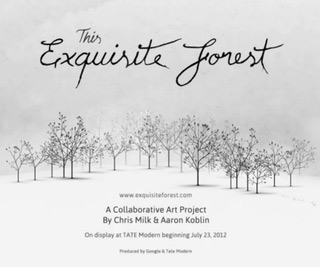 where someone inevitably managed to take the game in an inappropriate direction (wasn’t me, I swear).
If you do not recognize the creative exercise by its proper name, you will by its concept: a person begins a sentence or drawing on a piece of paper, covers their creation, passes the paper to the following person, and so the game continues until all participants have contributed. The final ‘masterpiece’ is often a comical, nonsensical, and potentially inappropriate, Dadaist anti-creation.
where someone inevitably managed to take the game in an inappropriate direction (wasn’t me, I swear).
If you do not recognize the creative exercise by its proper name, you will by its concept: a person begins a sentence or drawing on a piece of paper, covers their creation, passes the paper to the following person, and so the game continues until all participants have contributed. The final ‘masterpiece’ is often a comical, nonsensical, and potentially inappropriate, Dadaist anti-creation.
In July, Google’s Creative Lab teamed up with London’s Tate Modern Museum and launched the online collaborative project, “This Exquisite Forest.” Borrowing the game’s concept from the Surrealists, “This Exquisite Forest” enables users to draw or animate their own short animations (using Google Chrome browser) based on the initial “seeds” created by the artists Miroslaw Balka, Olafur Eliasson, Dryden Goodwin, Ragib Shaw, Julian Opie, Mark Titchner, Bill Woodrow, and Film4.0’s animators. One difference between the Surrealist’s version of the game and this project is the fact that online participants will have access to what was contributed before their own addition (as opposed to the Surrealist game where each participant's contribution is covered before moving on).
[embed]http://www.youtube.com/watch?feature=player_embedded&v=nnhJ1841K-8[/embed]
As users add their own animations and visual narratives using a web-based drawing tool, “the videos dynamically branch out and evolve, forming multiple new visuals.” From this idea- of initial videos or “seeds” planted by Tate’s artists- and the additional sequences branching out to create trees, this collaborative online project was coined “This Exquisite Forest.”
The project exists both in the digital realm and in the physical world. Large-scale projections of the best of the online contributions are displayed in the Level 3 gallery of the Tate Modern. In-house visitors have the opportunity to view the animations and contribute their own additions using digital drawing stations in the gallery.
“This Exquisite Forest” does three things expertly:
1) Allows museum-goers and web-users to become creators and curators, not just passive consumers of art
2) Provides a forum for the global, online community to collaborate creatively
3) Markets Google’s web browser Chrome, Google App Engine, and Google Cloud Storage
The physical installation at the Tate will run until January 2013 (approximately).
An Uncontroversial Use of Cell Phones in Movie Theaters with This American Life Live
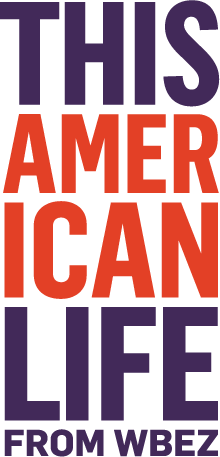 This American Life Live made us use our cell phones in theaters this last Thursday, May 10, 2012. It was great. In fact is was so engaging that we made music together. The audience stomped and snapped their fingers along to music that OK Go was playing live.
The instructions were: if you have an iPhone or an Android you were to download the This American Life Live app before coming to the show. The app was written in part by one of the members of OK Go to enable the audience to play a backup part to the music that the band was playing. Those without smart phones had a role too. They stopped and snapped their fingers. The cues for this were scrolled down a split screen (with the band on the other half of the split screen) in a similar fashion to the cues for Guitar Hero or Rock Band (though actually a bit easier to read). The warm up song was a hand bell version of Nirvana's Smells Like Teen Spirit followed by Ok GO's Needing/Getting. The theater rang with music from over the speakers but was lent depth by the sounds generated by the mobile devices. There was a palpable sense of excitement as people tried to keep up with the musical instructions and percussive stopping directions. It was easy to sense the engagement and the audience was giddy and laughter rang out after the collective performance. All in all it was a great success.
This American Life Live made us use our cell phones in theaters this last Thursday, May 10, 2012. It was great. In fact is was so engaging that we made music together. The audience stomped and snapped their fingers along to music that OK Go was playing live.
The instructions were: if you have an iPhone or an Android you were to download the This American Life Live app before coming to the show. The app was written in part by one of the members of OK Go to enable the audience to play a backup part to the music that the band was playing. Those without smart phones had a role too. They stopped and snapped their fingers. The cues for this were scrolled down a split screen (with the band on the other half of the split screen) in a similar fashion to the cues for Guitar Hero or Rock Band (though actually a bit easier to read). The warm up song was a hand bell version of Nirvana's Smells Like Teen Spirit followed by Ok GO's Needing/Getting. The theater rang with music from over the speakers but was lent depth by the sounds generated by the mobile devices. There was a palpable sense of excitement as people tried to keep up with the musical instructions and percussive stopping directions. It was easy to sense the engagement and the audience was giddy and laughter rang out after the collective performance. All in all it was a great success.
The success of this event want predicated upon the idea that the rules will have to be broken. Ira Glass stated during his introduction to the piece using cell phones that he, himself had to call the heads of two movie theater companies to clear the usage of cell phones in the theaters he was using. The convention of not using cell phones helps to create a positive experience for other patrons during a regular show. The usage of these devices as part of the show was a refreshing and creative way to break the rules and to let the cell phone juju out. Interestingly after the cell phone piece no one in the audience ventured to use their phones.
Perhaps the best and most effective way to discourage cell phone use in a theater is to provide engaging and captivating content. A sure sign that a performance is failing to engage is cell phone use which is an indicator that checking out is occurring. A recap of the This American Life Live event has links and images of the performance including a Terry Gross and Mike Birbiglia short film which is priceless.
The O: Audience Engagement at the Museum of Old and New Art in Tasmania
A recent blog post by the Walker Art Center featured some highlights from the Museums and the Web Conference that took place in San Diego earlier this month. Among these conference notes, the audience engagement practices at the Museum of Old and New Art (MONA) in Tasmania were undoubtedly innovative.
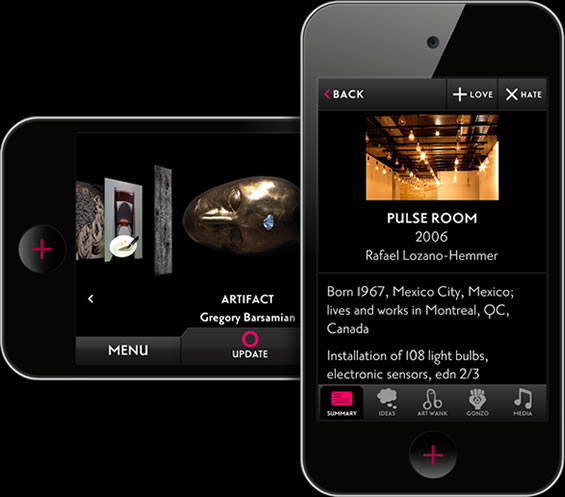 The 6000 sq ft privately owned museum, which has an “eclectic collection of 2210 antiquities and artworks,” has not a single wall label or sign to guide its visitors. Instead it relies on The O, “the first mobile interpretive solution designed to replace traditional wall labels and signage.”
The 6000 sq ft privately owned museum, which has an “eclectic collection of 2210 antiquities and artworks,” has not a single wall label or sign to guide its visitors. Instead it relies on The O, “the first mobile interpretive solution designed to replace traditional wall labels and signage.”
The O, a mobile device, equips a visitor with all the information they require including museum maps and cafe hours. Additionally, the O uses a visitor’s geo-location to suggest nearby artworks, allowing them to select the artworks they would like to know more about. It then goes on to provide them with curatorial information such as viewing notes and artist interviews. But even here, the approach is unique.
A visitor at the MONA recently wrote about her experience with The O and she mentioned how information on a particular artwork can be viewed in different styles. So Artwank presents you with information in “a formal curatorial style,” while Gonzo provides you with “personal musings on the art from MONA’s owner David Walsh.”
Besides curatorial information, The O lets a visitor interact with an artwork by leaving comments, tweeting about it, and sharing it on Facebook. It even has features that allow them to indicate whether love or hate it; art lends itself well to such extremes. Visitors also have the option of saving their O Tours and retrieving them the next day on MONA’s website. In fact, access to the museum’s online collection is reserved exclusively for those who saved their O Tours.
For the MONA’s curators and museum staff, The O unlocks a lot more than art. It provides them with a whole array of statistics that can be used to improve the visitor experience.The shuffled movement of MONA visitors using The O can provide stats on the most visited artworks, the most visited rooms, artworks with most likes, the number of tours, museum traffic, repeat visitors etc. Yes, The O is for omniscient.
According to Art Processors, the creators of The O, the device is used at the MONA by over 40,000 visitors per month. Since the MONA’s opening in January, 70% of visitors have indicated that they prefer The O to traditional signage and 80% said that the device enhanced their museum experience.
http://vimeo.com/40188545
The O improves on the visitor experience in several ways. They no longer huddle around a single text panel, reading the description at unimaginable speeds. Their path through the museum is altered by The O’s suggestions, leading them in unexpected directions and towards unseen artworks. They can revisit their tour in 3D on the museum’s website.
Museums have much to benefit from a device like The O. They may, at times, miss the reassurance of wall texts. But they can rest assured that with a device like The O, visitors will have access to a lot more than curatorial text. Conversely, the same visitors will leave behind a dotted trail that can be traced and analyzed by the museum. The O is for opportunity.
BMW Tate Live: An Online Space for Performance Art
On March 22nd, Jérôme Bel, a french choreographer and dancer, performed in an unknown room at the Tate Modern to an equally unknown audience. Odd as it may seem, there was not a single audience member present in the room. Those who were watching the performance were watching it online, inhabiting a newly unveiled virtual space called the BMW Tate Live: Performance Room.
 “The BMW Tate Live: Performance Room is an innovative series of performances broadcast viewable exclusively online around the globe, as they happen.”
“The BMW Tate Live: Performance Room is an innovative series of performances broadcast viewable exclusively online around the globe, as they happen.”
It is the outcome of “a partnership between BMW and Tate, which focuses on performance, interdisciplinary art and curating digital space.” Jérôme Bel’s performance was the first in a series of five online performances that will run through July, featuring the work of artists Pablo Bronstein, Harrell Fletcher, Joan Jonas and Emily Roysdon.
The idea of an exclusively online performance is perhaps more innovative than the technology being used to showcase it, a Youtube channel and a single camera. Catherine Wood, the Tate’s curator of Contemporary Art and Performance, explained in article on Artinfo that they wanted to transmit the work in the “simplest means” and a single camera essentially acted as the “fourth wall” of the performance space.
Additionally, the integration of Twitter, Facebook, and Google+, allows the audience to write comments during the performance and later pose questions to the curators and artists. This allows for the creation of a virtual audience that is connected in real-time through reactions, thoughts, and the Twitter phenomenon, hash tags (#BMWTateLive). Access to these real-time reactions from around the world truly is phenomenal and wouldn't be possible in a traditional setting. The trade-off, however, could be the evolution of an audience that tweets more than it sees, and comments more than it listens.
When asked by Artinfo on whether this online medium may take something away from a live performance, Catherine Wood replied that there has already been much debate “about how much performance documentation is the work and how much it is a record of the work.” But she added that “Live-ness is inherently mediated by technology in the world we live in now. There will always be a place for just a person in a room and a live audience, but I think this is part of the evolution of performance art that we can't ignore."
http://www.youtube.com/watch?v=kf77fzBOoNo
For those afraid of testing the niche waters of contemporary performance art, the increased accessibility and chance to experience an unfamiliar genre through YouTube cannot be ignored. A few swells of interest, a little online momentum, and the waters of performance art will seem a lot less murky or impenetrable. As of the 4th of April, Jérôme Bel’s performance has been viewed 862 times, but that doesn't take into account the number of people who watched it live.
In order to participate in the ongoing conversation, a viewer must to tune into the Tate's website or YouTube channel as the performance is being broadcast. Since the remaining performances are scheduled to take place at 20.00 hours (London), they will be most accessible to audiences in North America (~15.00 hours) and Europe (~21.oo hours), with the exception of a few arty insomniacs in Asia (~1.00 hours). But for those who may be asleep or at work, each performance is archived and uploaded to YouTube.
The next performance is scheduled for April 26 and features Pablo Bronstein, an Argentinian artist who uses “architectural design and drawing to engage with the grandiose and imperial past of the built environment.” In his performance, Bronstein “will work with up to ten dancers to create a baroque trompe l’oeil stage set that exaggerates the perspective within the Performance Room.”
If time permits, tune in to BMW Tate Live for Pablo Bronstein! You may lose your sense of perspective, but find a deeper understanding and appreciation for performance art. If time doesn't permit, don’t miss out on the opportunity to watch these performances on YouTube at a later date.


